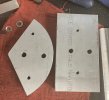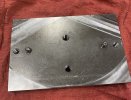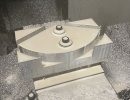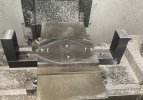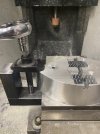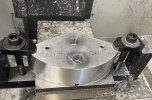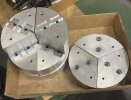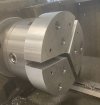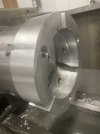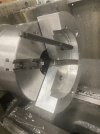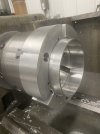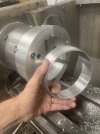KeithB
Resident Half Fast Machinist
I bid on a project to make some air inlet trim rings and got the job. Here is an example. (I edited the photo slightly to occlude the manufacturer's part ID#.) I made some of a slightly different design for one of our customers, who told another customer, who eventually contacted us. Another word-of-mouth situation.
There are several steps that need to be taken to do this job. (a) I need to find a good way to prepare the material. (b) I need to make a set of round soft jaws for my lathe chuck in four sizes, and (c) I need to make a better CAD drawing of the parts.
The customer who contracted for the first set of rings supplied the material, which was 6061 aluminum tubing. When I bid on the second job I had to include the material cost. It turns out that solid round stock is cheaper than tubing! These inlet rings come in 4 sizes from 3-3/4" to 6" OD and finish at 1-3/4" long. Boring out the center of a solid blank in steps is time consuming and wasteful; the cost of the extra time negates any savings in material cost.
I decided that using a hole saw to remove a plug of material may be the best way to prep the blanks. It can make a large hole in one step, and it doesn't waste much material - the resulting plug can be used to make a smaller size ring! I think I can drill a little over an inch deep from both sides. So I ordered four hole saws and a couple of arbors from our local tool vendor.
When I picked them up the counterman asked me what I was going to do with them and I told him. He looked at the biggest one (5-1/2"), cocked his head a little and asked how I planned to drive it. I whipped out my Iphone and showed him our new toy. He agreed that would probably handle it...
Sample inlet ring
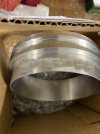
I used $398 of my stimulus money to buy this toolbox at Home Depot. We have several other mobile toolboxes in Husky brand and have been very satisfied with the quality and cost. This is 46" wide x 27" deep, has roller bearing on the drawers, rolls very easily, and has a pretty nice wood top.
Husky tool box
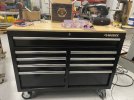
Here are our hole saws. 2-1/2", 3-1/2", 4-1/2", 5-1/2" + 2 arbors.
Hole saws
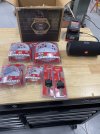
Our new radial arm drill being unloaded. Ought to be a real hole-saw driver!
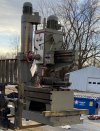
Tomorrow I plan to try sawing out a sample blank. I'll post the results.
There are several steps that need to be taken to do this job. (a) I need to find a good way to prepare the material. (b) I need to make a set of round soft jaws for my lathe chuck in four sizes, and (c) I need to make a better CAD drawing of the parts.
The customer who contracted for the first set of rings supplied the material, which was 6061 aluminum tubing. When I bid on the second job I had to include the material cost. It turns out that solid round stock is cheaper than tubing! These inlet rings come in 4 sizes from 3-3/4" to 6" OD and finish at 1-3/4" long. Boring out the center of a solid blank in steps is time consuming and wasteful; the cost of the extra time negates any savings in material cost.
I decided that using a hole saw to remove a plug of material may be the best way to prep the blanks. It can make a large hole in one step, and it doesn't waste much material - the resulting plug can be used to make a smaller size ring! I think I can drill a little over an inch deep from both sides. So I ordered four hole saws and a couple of arbors from our local tool vendor.
When I picked them up the counterman asked me what I was going to do with them and I told him. He looked at the biggest one (5-1/2"), cocked his head a little and asked how I planned to drive it. I whipped out my Iphone and showed him our new toy. He agreed that would probably handle it...
Sample inlet ring

I used $398 of my stimulus money to buy this toolbox at Home Depot. We have several other mobile toolboxes in Husky brand and have been very satisfied with the quality and cost. This is 46" wide x 27" deep, has roller bearing on the drawers, rolls very easily, and has a pretty nice wood top.
Husky tool box

Here are our hole saws. 2-1/2", 3-1/2", 4-1/2", 5-1/2" + 2 arbors.
Hole saws

Our new radial arm drill being unloaded. Ought to be a real hole-saw driver!

Tomorrow I plan to try sawing out a sample blank. I'll post the results.

